Total Hip Replacement in Dogs
The Hip Joint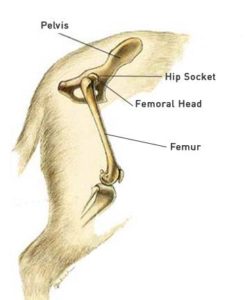
The hip is a ball and socket joint. The normal hip has a tight fit and the smooth cartilage surfaces of the ball and socket slide against each other with minimal friction. The hip itself is surrounded by a thin capsule and contains a small amount of lubricating joint fluid. Muscles, ligaments, and tendons contribute to the stability of the hip joint, and guide its motion during activities such as walking and running.
Hip Dysplasia and Hip Arthritis
Hip dysplasia refers to an abnormal formation of the hip joint.
The dysplastic hip has a shallow socket, which causes the joint to be loose and unstable. The poor fit between the ball and socket allows the ball to partially dislocate out of the socket. Over time this leads to arthritis of the hip.
The basic features of hip arthritis include:
- Friction and fluid accumulation within the joint
- Loss of the cartilage surfaces of the joint
- Thickening of the joint capsule
- Alterations of the adjacent bone
These changes cause joint stiffness, loss of hip joint motion and pain. Dogs with debilitating hip arthritis may have difficulty rising, show a choppy gait with frequent “bunny-hopping”, and may be reluctant to run, jump or climb stairs
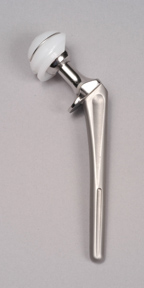
Cemented hip replacement components
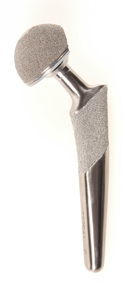
Non-cemented hip replacement components
Indications for Total Hip Replacement
Total hip replacement is an established treatment for painful hip arthritis in dogs.
The procedure is very similar to hip replacement in humans. The diseased joint is removed and replaced with an artificial joint made up of a polished chrome ball and a tight-fitting polyethylene plastic cup. This new prosthetic joint functions very similarly to a normal hip joint.
Total hip replacement is usually performed for the treatment of hip dysplasia and associated arthritis. It can also be performed to treat some injuries, such as hip fractures or dislocations.
Hip replacement can be performed in dogs less than one year of age for treatment of early severe hip dysplasia; however, it is more commonly performed in middle-aged dogs for the treatment of severe or worsening arthritis.
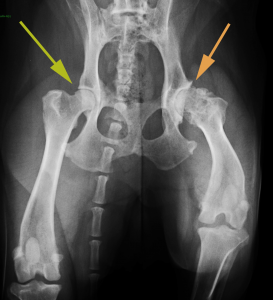
Hip Xrays showing a normal (green arrow )and a severely arthritic (orange arrow) hip joint.
Assessing a Patient for Hip Replacement
Dogs are screened carefully before hip replacement. A physical examination is performed to identify other problems that might affect the success of the procedure. X-rays of the hips are taken to assess the condition of the joint and the severity of arthritis, as well as to plan the procedure.
The physical examination will evaluate the following areas:
- Knee injuries, back pain or neurological impairments, and muscle strains
- Problems with abdominal organs
- Skin, teeth and ears are inspected carefully for signs of infection.
- Complete blood count, blood chemistry tests, and urinalysis are run to evaluate general health and to rule out bladder infection.
Alternatives to Hip Replacement
Most dogs with painful hip arthritis benefit greatly from weight loss, moderate exercise, joint supplements, and anti-inflammatory medications. Additional treatments may include laser and shock wave therapy or direct injection of the hip joint with lubricating agents such as hyaluronic acid (HA), platelet-rich plasma (PRP), or stem cells.
Conservative treatments are usually tried first. If the response is good, hip replacement may be postponed, or may become unnecessary.
Timing of Hip Replacement
When hip arthritis causes constant pain despite conservative treatments, or if a dog requires daily medication to maintain mobility and quality of life, hip replacement is a good option to consider. Loss of hind leg musculature (atrophy) is common in dogs with hip arthritis. Hip replacement is best performed before this muscle loss becomes severe.
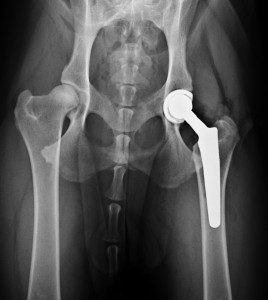
Xray showing a non-cemented total hip replacement.
The Hip Replacement Procedure
Dogs are fully anesthetized and carefully monitored throughout the surgical procedure. Epidural medication may be given to control pain. The arthritic portions of the joint are removed and replaced with metal and plastic components.
In a cemented hip replacement, the implants are held in place with acrylic cement. In non-cemented hip replacements, the surface of the components is beaded, and the implants become anchored over several weeks as new bone from the body grows into this porous surface.
Dogs remain hospitalized after the procedure and receive fluids, antibiotics, and pain medications overnight. Most dogs can bear some weight on the leg and can go home one to two days after the procedure.
Aftercare
Strict exercise restriction is critically important for several weeks after the procedure. Running, jumping, rough play with other animals, and unsupervised activity off-leash must be avoided. Short leash walks several times per day are ideal. Sling support of the hind legs will need to be provided during walks. Formal physical rehabilitation can accelerate recovery and enhance the outcome.
Outcomes and Complications
Hip replacement has a high success rate. The procedure relieves pain and restores excellent function in over 90% of cases. Most dogs show dramatic improvement after the replacement of only one hip. Major complications of hip replacement include infection, dislocation or loosening of the prosthetic joint components, fracture, and nerve injury. Rarely, complications may require additional surgery and even the removal of the implants. The risk of complications is minimized with careful planning, attention to detail during the procedure, and diligent aftercare.